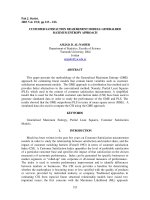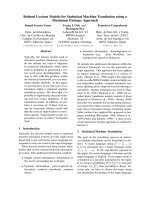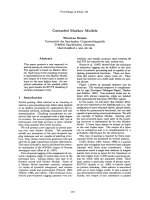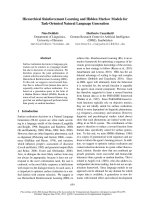Maximum entropy markov models
Bạn đang xem bản rút gọn của tài liệu. Xem và tải ngay bản đầy đủ của tài liệu tại đây (188.13 KB, 26 trang )
1
Maximum Entropy Markov Models
for Information Extraction and Segmentation
Andrew McCallum, Dayne Freitag, and Fernando Pereira
17th International Conf. on Machine Learning, 2000
Presentation by Gyozo Gidofalvi
Computer Science and Engineering Department
University of California, San Diego
May 7, 2002
2
Outline
• Modeling sequential data with HMMs
• Problems with previous methods: motivation
• Maximum entropy Markov model (MEMM)
• Segmentation of FAQs: experiments and results
• Conclusions
3
Background
• A large amount of text is available on the Internet
– We need algorithms to process and analyze this text
• Hidden Markov models (HMMs), a “powerful tool
for representing sequential data,” have been
successfully applied to:
– Part-of-speech tagging:
<PRP>He</PRP> <VB>books</VB> <NNS>tickets</NNS>
– Text segmentation and event tracking:
tracking non-rigid motion in video sequences
– Named entity recognition:
<ORG>Mips</ORG> Vice President <PRS>John Hime</PRS>
– Information extraction:
<TIME>After lunch</TIME> meet <LOC>under the oak tree</LOC>
4
Brief overview of HMMs
• An HMM is a finite state automaton with
stochastic state transitions and observations.
• Formally: An HMM is
– a finite set of states
S
– a finite set of observations
O
– two conditional probability distributions:
• for
s
given
s’
: P(
s
|
s’
)
• for
o
given
s
: P(
o
|
s
)
– the initial state distribution P
0
(
s
)
s
’
s
o
evidence
cause
Dependency graph
5
The “three classical problems” of HMMs
•
Evaluation
problem: Given an HMM, determine the probability of a
given observation sequence :
•
Decoding
problem: Given a model and an observation sequence,
determine the most likely states that led to the observation sequence
:
•
Learning
problem: Suppose we are given the structure of a model
(
S
,
O
) only. Given a set of observation sequences determine the best
model parameters.
• Efficient dynamic programming (DP) algorithms that solve these
problems are the Forward, Viterbi, and Baum-Welch algorithms
respectively.
1
,,
T
oo o
= !
1
,,
T
ss s
= !
arg max ( , ) ( | , ) ( )
s
Po Po s Ps
θ
θθ
=
∑
arg max ( | )
s
Po s
() ( | )()
s
Po Po s Ps
=
∑
6
Assumptions made by HMMs
•
Markov assumption
: the next state depends only on the
current state
•
Stationarity assumption
: state transition probabilities are
independent of the actual time at which transitions take
place
•
Output independence assumption
: the current output
(observation) is independent of the previous outputs
(observations) given the current state.
7
Difficulties with HMMs: Motivation
• We need a richer representation of observations:
– Describe observations with overlapping features
• When we cannot enumerate all possible observations (e.g. all
possible lines of text) we want to represent observations by
feature values.
– Example features in text-related tasks:
• capitalization
• word ending
• part-of-speech
• formatting
• position on the page
• Model P(
s
T
|
o
T
) rather then the joint probability P(
s
T
,
o
T
)
Example task:
Extract company names
GenerativeDiscriminative / Conditional
8
Definition of a MEMM
• Model the probability of reaching a state given an
observation and the previous state
• finite set of states
S
• set of possible observations
O
• State-observation transition probability for
s
given
s’
and the current observation
o
: P(
s
|
s’
,
o
)
• initial state distribution: P
0
(
s
)
s
’
s
o
Dependency graph
evidence
cause
9
Given
o
and
s
, find
M
s.t.
P(
s
|
o
,
M
) is maximized
(Simpler Max likelihood problem)
Given
o
, find
M
s.t.
P(
o
|
M
) is maximized
(Need EM because S is unknown)
Learning
Find
s
T
s.t. P(
s
T
|
o
T
,
M
)
is maximized
Find
s
T
s.t. P(
o
T
|
s
T
,
M
)
is maximized
Decoding
=
Prediction
Find P(
o
T
|
M
) Evaluation
Discriminative / Conditional:
MEMM
Generative:
HMM
Task
s
’
s
o
s
’
s
o
10
DP to solve the “three classical problems”
•
α
t
(
s
) is the probability of being in state
s
at time
t
given the
observation sequence up to time
t
:
•
ß
t
(
s
) is the probability of starting from state
s
at time
t
given the observation sequence after time
t
:
'
11
|,''
tt t
Ss
sssPso
BB
¸
1
'|',
s
ttt
S
sPsoss
CC
(1)
(2)
11
Maximum Entropy Markov Models (MEMMs)
• For each
s’
separately conditional probabilities
P(
s
|
s’
,
o
) are given by an exponential model
• Each exponential model is trained via maximum
entropy
Note: P(
s
|
s’
,
o
) can be split into |
S
| separately trained
transition functions P
s’
(
s
|
o
) = P(
s
|
s’
,
o
).
12
Fitting exponential models by maximum entropy
• Basic idea:
– The best model of the data satisfies certain
constraints and makes the fewest possible
assumptions.
– “fewest possible assumptions”
≡
closest to the
uniform distribution (i.e. has highest entropy)
13
• Allow non-independent observation features
• Constraints are counts for properties of training data:
– “observation contains the word apple” and is labeled “header”
– “observation contains a capitalized word” and is labeled “question”
• Properties (called features) can depend on
observations and also their state label.
• Formally: A feature
f
a
is defined by
a
=
〈
b
,
r
〉
, where
–
b
is a binary feature of the current observation and
–
r
is a state value:
,
1
if is true and
,
0
tt
tt
br
bo s r
fos
otherwise
£
¦
¦
¤
¦
¦
¥
(3)
14
Constraints on the model
• For all s’ the expected value
E
a
of each feature
a
in the learned
distribution equals its average value
F
a
in training set:
• Theorem: The probability distribution with maximum entropy that
satisfies the constraints is (a) unique, (b) the same as the ML solution,
and (c) in exponential form. For a fixed
s’
:
where
λ
a
are the parameters to be learned and
1
|', exp ,
,'
aa
a
Pss o f os
Zos
M
¬
®
(| ',)
(, ')
(| ',)
Ss
Ps s o
Zo
Psos
s
(5)
(6)
' '
11
''
11
(| ', ) ( ,) ( , )
s s
mm
aa
S
s
kk kk
kk
s
s
a a
Psofo fos
mm
ss
EF
=∈ =
===
∑∑ ∑
(4)
15
MEMM training algorithm
1. Split the training data into observation -
destination state pairs
〈
o
,
s
〉
for each state
s’
.
2. Apply Generalized Iterative Scaling (GIS) for
each
s’
using its
〈
o
,
s
〉
set to learn the maximum
entropy solution for the transition function of
s’
.
This algorithm assumes that the state sequence for
each training observation sequence is known.
16
GIS [Darroch & Ratcliff, 1972]
• Learn the transition function for one origin state
s’
by finding
λ
a
values that satisfy
E
a
=
F
a
(Eq 4).
• Input for one origin state
s’
:
– training examples with this origin
s’
numbered 1 to
k
– for each of these training examples
• set of features
f
a
for
a
= 1…
n
– values for features for each context
〈
o
,
s
〉
must sum to constant
C
– Use correction feature
f
x
if necessary:
• Outputs: set of
λ
a
values for
a
= 1…
n
1
,,
a
a
n
x
fos C fos
17
1. Let
m
s
be the number of training examples where the current state is
s
(and the previous state is
s’
)
.
2. Calculate the relative frequency of each feature on the training data:
3. Initialize
λ
a
to some arbitrary value, say 1.
4. Use current
λ
a
values in Eq 5 to estimate P(
s
|
s’
,
o
)
5. Calculate the expectation of each feature “according to the model”:
6. Update each
λ
a
s.t. to make
E
a
be closer to the expectation of the
training data:
7. Repeat from step 4 until convergence.
1
1
,
s
kk
m
aa
s
k
Ffos
m
1
1
|', ,
s
m
aa
s
k
s
k
k S
EPsofs o
m
s
1
:loglog
aa a a
FE
C
MM
(7)
(8)
(9)
For a fixed
s’
:
18
Review of the MEMM model
{
s
=
s
1
}
{
s
=
s
k
}
GIS
s’=s
1
s’=s
k
f
1
f
2
…
f
n
…
…
Exponential
form for
P(
s
|
s’
,
o
)
{
λ
a
} for
s’
=
s
k
…
{
〈
s’
,
o
,
s
〉
s.t.
s’
=
s
1
}
{
〈
s’
,
o
,
s
〉
s.t. s’ = s
k
}
{
s
=
s
1
}
{
s
=
s
k
}
…
{
〈
s’
,
o
,
s
〉
s.t.
s’
=
s
k
and
s
=
s
1
}
{
λ
a
} for
s’
=
s
1
19
Application: segmentation of FAQs
• 38 files belonging to 7 Usenet multi-part FAQs (set of files)
• Basic file structure:
header
text in Usenet header format
[preamble or table of content]
series of one of more question/answer pairs
tail
[copyright]
[acknowledgements]
[origin of document]
• Formatting regularities: indentation, numbered questions,
types of paragraph breaks
• Consistent formatting within a single FAQ
20
• Lines in each file are hand-labeled into 4 categories:
head
,
questions
,
answers
,
tail
<head>X-NNTP-Poster: NewsHound v1.33
<head>
<head>Archive-name: acorn/faq/part2
<head>Frequency: monthly
<head>
<question>2.6) What configuration of serial cable should I use
<answer>
<answer> Here follows a diagram of the necessary connections
<answer>programs to work properly. They are as far as I know t
<answer>agreed upon by commercial comms software developers fo
<answer>
<answer> Pins 1, 4, and 8 must be connected together inside
<answer>is to avoid the well known serial port chip bugs. The
• Prediction: Given a sequence of lines, a learner must return
a sequence of labels.
Table 2: An excerpt from a labeled FAQ
21
Boolean features of lines
• The 24 line-based features used in the experiments are:
begins-with-number contains-question-mark
begins-with-ordinal contains-question-word
begins-with-punctuation ends-with-question-mark
begins-with-question-word first-alpha-is-capitalized
begins-with-subject indented
blank indented-1-to-4
contains-alphanum indented-5-to-10
contains-bracketed-number more-than-one-third-space
contains-http only-punctuation
contains-non-space prev-is-blank
contains-number prev-begins-with-ordinal
contains-pipe shorter-than-30
22
Experiment setup
• “Leave-
n
-minus-1-out” testing: For each file in a
group (FAQ), train a learner and test it on the
remaining files in the group.
• Scores are averaged over
n
(
n
-1) results.
23
Evaluation metrics
•
Segment
: consecutive lines belonging to the same category
•
Co-occurrence agreement probability
(COAP)
– Empirical probability that the actual and the predicted
segmentation agree on the placement of two lines according to
some distance distribution
D
between lines.
– Measures whether segment boundaries are properly aligned by the
learner
•
Segmentation precision
(SP):
•
Segmentation recall
(SR):
,
() ( )
(, ) (,)
() ( )
D
ij
actual i actual j
P actual predicted D i j
predicted i predicted j
¯
¡°
¡°
¡°
¡°
¡°
¢±
# of correctly identified segments
# of segments predicted
# of correctly identified segments
# of actual segments
24
Comparison of learners
•
ME-Stateless
: Maximum entropy classifier
– documents is an unordered set of lines
– lines are classified in isolation using the binary features,
not using label of previous line
•
TokenHMM
: Fully connected HMM with hidden
states for each of the four labels
– no binary features
– transitions between states only on line boundaries
•
FeatureHMM
: same as TokenHMM
– lines are converted to sequences of features
•
MEMM
25
Results
Learner COAP SegPrec SegRecall
ME-Stateless 0.520 0.038 0.362
TokenHMM 0.865 0.276 0.140
FeatureHMM 0.941 0.413 0.529
MEMM 0.965 0.867 0.681









